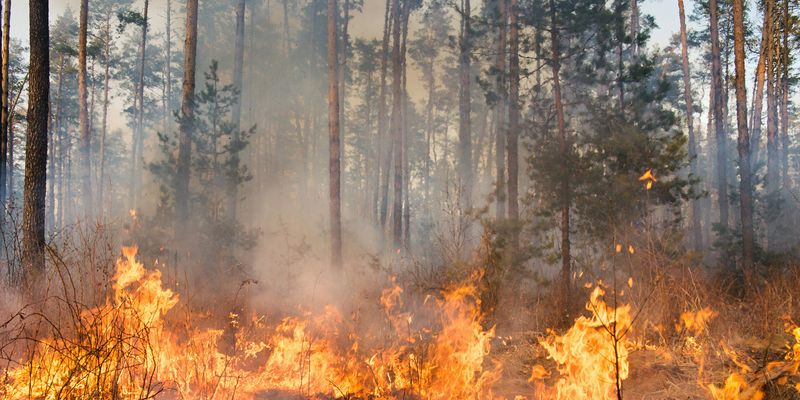Global Forest Destruction: Wildfires And The Record-Breaking Losses

Table of Contents
The Rising Threat of Wildfires
Wildfires are a significant driver of global forest destruction, and their frequency and intensity are escalating at an alarming rate. Several factors contribute to this rising threat.
Climate Change as a Primary Driver
Climate change is undeniably a primary driver of increased wildfire activity. Rising global temperatures, prolonged droughts, and altered precipitation patterns create ideal conditions for wildfires to ignite and spread rapidly. The Intergovernmental Panel on Climate Change (IPCC) reports a clear correlation between rising temperatures and increased wildfire frequency and severity. For example, the average global temperature has risen by approximately 1°C since the pre-industrial era, leading to more frequent and intense heatwaves and droughts.
- Examples of regions experiencing record-breaking wildfire seasons due to climate change:
- Australia: The 2019-2020 bushfire season was fueled by record-breaking heat and drought.
- California, USA: Repeated years of severe drought and extreme heat have led to massive wildfires.
- Siberia, Russia: Vast areas of the Siberian forests have been devastated by increasingly frequent and intense wildfires.
- Amazon rainforest: Deforestation and drought have increased the vulnerability of the Amazon to devastating fires.
Deforestation and its Role in Wildfire Spread
Deforestation significantly contributes to the increased risk and spread of wildfires. The removal of trees leaves behind drier conditions, creating a landscape more susceptible to ignition and rapid fire spread. Logging, agricultural expansion, and urbanization all contribute to deforestation, leading to fragmented forests and increased wildfire risk.
- Statistics on deforestation rates and their contribution to wildfire incidents: While precise figures attributing wildfires solely to deforestation are difficult to obtain, studies show a strong correlation between deforestation rates and increased wildfire occurrence in numerous regions. Data from organizations like Global Forest Watch provides valuable insights into deforestation trends globally.
Human Activities Igniting Wildfires
Human negligence and intentional acts are major causes of wildfires. Discarded cigarettes, unattended campfires, and power lines sparking during dry conditions are frequent culprits. Intentional forest burning, often for agricultural land clearing, can quickly escalate into uncontrollable wildfires with devastating consequences.
- Examples of major wildfires caused by human activities:
- Many wildfires in the western United States are attributed to power lines and downed power poles.
- Arson is suspected in some large wildfires, particularly those occurring during periods of high drought.
- Unattended campfires and discarded cigarettes are frequent causes of smaller, but still damaging, wildfires.
The Devastating Consequences of Global Forest Destruction
The consequences of global forest destruction, largely driven by wildfires, are far-reaching and devastating.
Biodiversity Loss and Ecosystem Collapse
Wildfires cause immense biodiversity loss. They destroy animal habitats, leading to displacement, injury, and death. Plant life is decimated, impacting the entire food web and disrupting ecosystem functions. Habitat loss and fragmentation increase the extinction risk for countless species.
- Examples of endangered species affected by forest destruction: Koalas in Australia, numerous bird species in California, and various Amazonian species are significantly impacted by wildfires and habitat loss.
Climate Change Exacerbation
Forest destruction significantly exacerbates climate change. Trees act as vital carbon sinks, absorbing CO2 from the atmosphere. Wildfires release vast amounts of stored carbon back into the atmosphere, contributing to greenhouse gas emissions and accelerating global warming. Deforestation further reduces the planet's capacity to absorb CO2.
- Statistics on carbon emissions from wildfires and deforestation: Wildfires release billions of tons of CO2 annually, while deforestation contributes significantly to global greenhouse gas emissions. Specific figures vary depending on the year and region, but data from sources like the Global Carbon Project provide valuable estimates.
Economic and Social Impacts
Wildfires cause substantial economic losses. Property damage, infrastructure destruction, and disruption to tourism and other industries can cost billions of dollars. The social impacts are equally severe, leading to displacement, health problems (smoke inhalation), and significant psychological distress for affected communities.
- Examples of economic and social costs from major wildfires: The economic costs of the 2019-2020 Australian bushfires were estimated in the tens of billions of dollars, while the social costs included widespread displacement and significant psychological trauma.
Mitigation and Conservation Strategies
Combating global forest destruction requires a multi-pronged approach encompassing prevention, mitigation, and conservation.
Preventing Wildfires
Preventing wildfires is crucial. This involves implementing controlled burns under specific conditions to reduce fuel loads, improving forest management practices to create firebreaks, and investing in early warning systems. Public awareness campaigns are vital to educate people about wildfire prevention and responsible behavior in forested areas.
- Examples of successful wildfire prevention programs: Many regions have implemented successful programs focusing on community engagement, controlled burning, and improved land management.
Reforestation and Forest Restoration
Replanting trees and restoring damaged forest ecosystems is essential for mitigating the effects of wildfires and deforestation. Various reforestation techniques, including direct seeding and planting seedlings, can be employed, with the choice depending on the specific ecological context.
- Examples of successful reforestation projects: Numerous organizations and governments have undertaken successful reforestation projects globally, contributing to forest regeneration and carbon sequestration.
International Cooperation and Policy
International cooperation and effective policies are critical to combating deforestation and wildfires globally. International agreements and sustainable forestry practices play a vital role in promoting responsible land management and reducing deforestation rates.
- Examples of international initiatives to protect forests: The Paris Agreement, REDD+ (Reducing Emissions from Deforestation and Forest Degradation), and various other international initiatives aim to protect forests and combat deforestation.
Addressing Global Forest Destruction: A Call to Action
Global forest destruction, significantly driven by increasingly frequent and intense wildfires, has devastating environmental, economic, and social consequences. The urgency of addressing this issue cannot be overstated. We need a concerted global effort involving prevention measures, reforestation initiatives, and strong international cooperation to mitigate the impact of wildfires and protect our forests. We must act now to combat global forest destruction. Learn more about supporting initiatives focused on wildfire prevention and forest conservation, and make a difference today. Find organizations dedicated to reforestation, forest management, and fighting climate change – your involvement matters.

Featured Posts
-
 Mntkhb Amryka Thlathy Jdyd Dmn Qaymt Bwtshytynw
May 22, 2025
Mntkhb Amryka Thlathy Jdyd Dmn Qaymt Bwtshytynw
May 22, 2025 -
 Blake Lively Alleged Controversies And Recent News
May 22, 2025
Blake Lively Alleged Controversies And Recent News
May 22, 2025 -
 Tory Politicians Wifes Jail Term Southport Incident And Aftermath
May 22, 2025
Tory Politicians Wifes Jail Term Southport Incident And Aftermath
May 22, 2025 -
 Google Searchs Ai Mode Evolution And Impact
May 22, 2025
Google Searchs Ai Mode Evolution And Impact
May 22, 2025 -
 Taylor Swift And Blake Livelys Friendship A Legal Battles Impact
May 22, 2025
Taylor Swift And Blake Livelys Friendship A Legal Battles Impact
May 22, 2025
Latest Posts
-
 Blake Lively And Taylor Swift Alleged Blackmail And Leaked Texts Amid Baldoni Feud
May 22, 2025
Blake Lively And Taylor Swift Alleged Blackmail And Leaked Texts Amid Baldoni Feud
May 22, 2025 -
 Blake Lively Faces A List Backlash The Power Of Family Support
May 22, 2025
Blake Lively Faces A List Backlash The Power Of Family Support
May 22, 2025 -
 Family First Blake Livelys Sisters Stand By Her Following A List Fallout
May 22, 2025
Family First Blake Livelys Sisters Stand By Her Following A List Fallout
May 22, 2025 -
 The Truth Behind The Blake Lively Allegations
May 22, 2025
The Truth Behind The Blake Lively Allegations
May 22, 2025 -
 Blake Livelys Family Supports Her Amidst Reported Feud With Taylor Swift And Gigi Hadid
May 22, 2025
Blake Livelys Family Supports Her Amidst Reported Feud With Taylor Swift And Gigi Hadid
May 22, 2025
